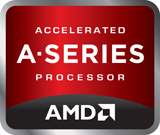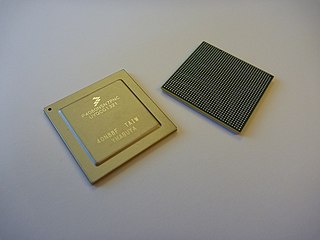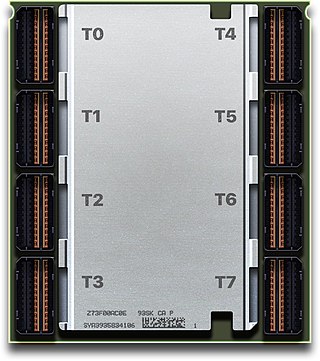
The PowerPC 970, PowerPC 970FX, and PowerPC 970MP are 64-bit PowerPC CPUs from IBM introduced in 2002. Apple branded the 970 as PowerPC G5 for its Power Mac G5.
Cell, a shorthand for Cell Broadband Engine Architecture, is a 64-bit multi-core microprocessor and microarchitecture that combines a general-purpose PowerPC core of modest performance with streamlined coprocessing elements which greatly accelerate multimedia and vector processing applications, as well as many other forms of dedicated computation.

POWER7 is a family of superscalar multi-core microprocessors based on the Power ISA 2.06 instruction set architecture released in 2010 that succeeded the POWER6 and POWER6+. POWER7 was developed by IBM at several sites including IBM's Rochester, MN; Austin, TX; Essex Junction, VT; T. J. Watson Research Center, NY; Bromont, QC and IBM Deutschland Research & Development GmbH, Böblingen, Germany laboratories. IBM announced servers based on POWER7 on 8 February 2010.
The PowerPC 400 family is a line of 32-bit embedded RISC processor cores based on the PowerPC or Power ISA instruction set architectures. The cores are designed to fit inside specialized applications ranging from system-on-a-chip (SoC) microcontrollers, network appliances, application-specific integrated circuits (ASICs) and field-programmable gate arrays (FPGAs) to set-top boxes, storage devices and supercomputers.
The transistor count is the number of transistors in an electronic device. It is the most common measure of integrated circuit complexity. The rate at which MOS transistor counts have increased generally follows Moore's law, which observes that transistor count doubles approximately every two years. However, being directly proportional to the area of a die, transistor count does not represent how advanced the corresponding manufacturing technology is. A better indication of this is transistor density which is the ratio of a semiconductor's transistor count to its die area.

The Qosmio series was Toshiba's consumer-marketed line of high performance multimedia-oriented desktop replacement laptops. The first Qosmio laptop was released on July 25, 2004 as the E15-AV101 with a 1.7 GHz Intel Pentium M CPU, 512 megabytes of DDR SDRAM, and a 15-inch XGA 1024x768 screen. Toshiba's most powerful laptop has undergone many revisions, with focus shifting from high-end multimedia functionality to heavy gaming. The last line under the Qosmio name, the X70 series, was released in 2013, featuring an Intel Core i7 processor with up to 32 gigabytes of DDR3 SDRAM and an Nvidia GeForce GTX 770M as well as a 17.3-inch Full HD display.
Torrenza was an initiative announced by Advanced Micro Devices (AMD) in 2006 to improve support for the integration of specialized coprocessors in systems based on AMD Opteron microprocessors. Torrenza does not refer to a specific product or specific technology, though the primary focus is on the integration of coprocessor devices directly connected to the Opteron processors' HyperTransport links, and other co-processors connected via PCI Express. The initiative's stated goals include improving technical and technology support for third-party developers of coprocessing devices, reducing the cost of implementing HyperTransport interfaces on these devices, and improving the performance of the integrated system. It can be argued, that the original idea behind Torrenza was successfully implemented in form of Heterogeneous System Architecture by AMD and the other members of the HSA Foundation.
Cell microprocessors are multi-core processors that use cellular architecture for high performance distributed computing. The first commercial Cell microprocessor, the Cell BE, was designed for the Sony PlayStation 3. IBM designed the PowerXCell 8i for use in the Roadrunner supercomputer.

AMD Accelerated Processing Unit (APU), formerly known as Fusion, is a series of 64-bit microprocessors from Advanced Micro Devices (AMD), combining a general-purpose AMD64 central processing unit (CPU) and 3D integrated graphics processing unit (IGPU) on a single die.

Larrabee is the codename for a cancelled GPGPU chip that Intel was developing separately from its current line of integrated graphics accelerators. It is named after either Mount Larrabee or Larrabee State Park in the state of Washington. The chip was to be released in 2010 as the core of a consumer 3D graphics card, but these plans were cancelled due to delays and disappointing early performance figures. The project to produce a GPU retail product directly from the Larrabee research project was terminated in May 2010 and its technology was passed on to the Xeon Phi. The Intel MIC multiprocessor architecture announced in 2010 inherited many design elements from the Larrabee project, but does not function as a graphics processing unit; the product is intended as a co-processor for high performance computing.
The i.MX range is a family of NXP proprietary microprocessors dedicated to multimedia applications based on the ARM architecture and focused on low-power consumption. The i.MX application processors are SoCs (System-on-Chip) that integrate many processing units into one die, like the main CPU, a video processing unit, and a graphics processing unit for instance. The i.MX products are qualified for automotive, industrial, and consumer markets. Most of them are guaranteed for a production lifetime of 10 to 15 years.

QorIQ is a brand of ARM-based and Power ISA–based communications microprocessors from NXP Semiconductors. It is the evolutionary step from the PowerQUICC platform, and initial products were built around one or more e500mc cores and came in five different product platforms, P1, P2, P3, P4, and P5, segmented by performance and functionality. The platform keeps software compatibility with older PowerPC products such as the PowerQUICC platform. In 2012 Freescale announced ARM-based QorIQ offerings beginning in 2013.
The ZEGO is a rackmount server platform built by Sony, targeted for the video post-production and broadcast markets. The platform is based on Sony's PlayStation 3 as it features both the Cell Processor as well as the RSX 'Reality Synthesizer'. It is aimed to greatly speed up postproduction work, 3D rendering and video processing. In some respects it is rather similar to IBM's QS20/21/22 blades, although Sony seems to target the DCC markets rather than scientific like IBM, which can be seen by the inclusion of the RSX graphics processor in the ZEGO platform.

Fixstars Solutions, Inc. is a software and services company specializing in multi-core processors, particularly in Nvidia's GPU and CUDA environment, IBM Power7, and Cell. They also specialize in solid-state drives and currently manufacture the world's largest SATA drives.
The IBM A2 is an open source massively multicore capable and multithreaded 64-bit Power ISA processor core designed by IBM using the Power ISA v.2.06 specification. Versions of processors based on the A2 core range from a 2.3 GHz version with 16 cores consuming 65 W to a less powerful, four core version, consuming 20 W at 1.4 GHz.
Zero ASIC Corporation, formerly Adapteva, Inc., is a fabless semiconductor company focusing on low power many core microprocessor design. The company was the second company to announce a design with 1,000 specialized processing cores on a single integrated circuit.

POWER9 is a family of superscalar, multithreading, multi-core microprocessors produced by IBM, based on the Power ISA. It was announced in August 2016. The POWER9-based processors are being manufactured using a 14 nm FinFET process, in 12- and 24-core versions, for scale out and scale up applications, and possibly other variations, since the POWER9 architecture is open for licensing and modification by the OpenPOWER Foundation members.
Coherent Accelerator Processor Interface (CAPI), is a high-speed processor expansion bus standard for use in large data center computers, initially designed to be layered on top of PCI Express, for directly connecting central processing units (CPUs) to external accelerators like graphics processing units (GPUs), ASICs, FPGAs or fast storage. It offers low latency, high speed, direct memory access connectivity between devices of different instruction set architectures.

Power10 is a superscalar, multithreading, multi-core microprocessor family, based on the open source Power ISA, and announced in August 2020 at the Hot Chips conference; systems with Power10 CPUs. Generally available from September 2021 in the IBM Power10 Enterprise E1080 server.










